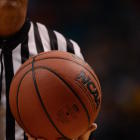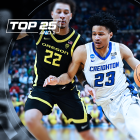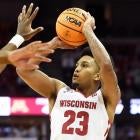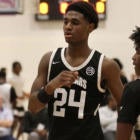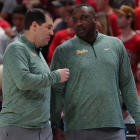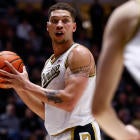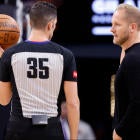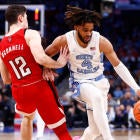Small but significant rule changes are coming to college basketball this season, tweaks to the system that every fan should know about. I spoke with head of NCAA officiating J.D. Collins this week to discuss the changes, why they were made and the NCAA's overall push to get this information out there as general knowledge in advance of the 2016-17 regular season.
The way it works is, every two years the NCAA has a chance to adopt big changes to its rule book. (That's why we had the change from a 35-second to a 30-second shot clock last season, for instance.) But it's a non-rules change year, in fact, so widespread legislation isn't on the table. However, points of emphasis and alterations to current rules are allowed. The rules committee did just that.
There are four focal points the NCAA and college basketball are honing in on. First and foremost, reducing physicality -- especially in the post -- is pivotal. Things like body-bumping the ball handler, outward bumps on screens, freedom of movement for offensive players with the ball, and "offensive-initiated" contact for legal defenders are also going to be strictly legislated on the floor.
The NCAA wants more offense, less brute force and better flow to its game. It saw gains in this last year but there is plenty of work to be done. Here's what to know and look for this season.
1. Coaches got some of their calling-timeout capability back
Last season, the most common lament from coaches was how they could not call a timeout in any live-ball situation. That is still the case ... mostly. Now, coaches will have the ability to call a timeout when a ball is "live" after a made basket on an inbound situation.
The idea behind getting rid of coaches calling TOs in live-ball situations came down to a lot of guys just yelling "timeout!!" when a ball was in a scrum and possession wasn't determined.
"We got rid of it, it's effective," Collins said.
This is probably going to be the rule from here on out, a compromise between total autonomy with a coach calling timeout while still allowing them to stop the game during important, pivotal moments when the ball is not yet inbounds.
2. Double-foul calls are going to rise dramatically this season
Post play physicality and "rebounding displacement" are two huge points of emphasis. The latter is mostly about officials' placement on the floor, but the former is going to take teams and coaches time to adjust. To put it frankly, when a guy with the ball is in the post, he can "shape up" by bending his elbows. He cannot use his arms to prevent a defender from getting around him, though. If that happens, it's now an automatic foul.
Alternatively, when a defender in the post "lays" on an offensive player or attempts to put a hand through or go under the offensive player's arm -- it's called "swim-stroking" -- that's a foul. The legal way to defend is to get around the player, to front him or to "three-quarter" him. A single forearm is legal in post area, but a defender can't use a forearm and a hand.
"Fifty to 60 percent of the time, both of those actions happen at the same time," Collins said. "So it will be a foul on both players, the offense retains the ball and the shot clock is not reset."
3. Travels are also going to spike
Collins calls it a "focus on obvious travels on the perimeter and post travels -- picking up the pivot foot."
It's become normal basketball movement to accept a pass and then take a tiny hop to set/square one's self. That's technically a travel. It will now be called as such. Players in the post who use that ever-so-slight adjustment to their pivot foot to set before dribbling the ball to make a move will also be whistled.
"They seem incidental, but it's a huge advantage to be able to reset his feet like that," Collins said.
4. Charges should continue to go down, and the Big Ten and MAC are going to conduct an unprecedented review experiment
This is the item getting attention because the NCAA announced the Big Ten and the MAC will now have the ability to review block/charge plays and overturn calls when applicable in the final two minutes of a game. The decision has come with some speculation and pushback, but it's important to note this is only going to be applied in those two specific leagues' conference games. They are guinea pigs to see if reviewing block/charges proves worthwhile -- and if so, would be something that is adopted throughout Division I in a year from now.
"If it shows that 15 games that could have had outcomes changed, let's make it a sport-wide rule change for next year," Collins said.
Collins also said college basketball's average time to complete a game was faster last year, the efficiency of using monitor reviews was up, and the sport is finishing games, on average, in under two hours.
"During the majority of the game, get in and get out, because people don't want to be delayed in watching their games," Collins said. "But when the game is in the balance, you have to take the time necessary to get the play right."
Reviews on block/charge calls can be prompted by a coach's protest (if wrong, the coach/his team would lose a timeout) or at the discretion of the officiating crew.
In terms of charges, the NCAA is encouraging defenders to jump, to use their athleticism. When starting inside the semi-circle near the hoop, if a defender jumps straight up and his hands continue to "wall up" by staying vertical, the defender will have the right to that space and not be called for a foul. Also, if a defender is sliding into a spot to draw a charge at the last second, charges will not be called unless forward momentum by the offensive player is egregious.
"You'll have more plays where a guy on offense creates contact, perhaps incidental," Collins said. "Could it be a charge? Yes, but he would have to come in too hard. The opposite side is when a defender remains grounded, feet on the floor, and any contact for a foul it has to be a blocking foul. The original purpose of the arc is to get people out of there, so there's not all these crashes at the hoop. This new rule is going to allow players to be in there but they are encouraging good defensive players to wall up there. We don't want player standing in there to create contact or draw charges."
A byproduct of this: By getting defenders out of the circle, flagrant-elbow calls should also drop this season.

5. Offensive players will be granted more natural movement with the ball
This is a point of emphasis that should allow for a freer game on both ends. Offensive and defensive players are allowed a certain amount of space to make natural, normal basketball moves. For the offense, a "normal basketball play" starts with either a shot attempt, a pass or a dribble. In a sentence: An offensive player should be able to make a move without having someone jamming up on them and restricting them.
"When you think about where the game has come in the past 25 years, in the post, the rules today are exactly the same as they were 25 years ago. And yet we've allowed more and more physical contact to happen, and that can't be acceptable. And what you're seeing from the rules committee is allowing offensive players the freedom to be able to allowed what they're able to do within the rules."
Collins said when teams trap or double team, fouls will likely go up as players and coaches adapt to the nuanced difference between resolute defense vs. completing impeding an offensive player's rightful space to make a basketball move. Defense is important, but smothering a player to the point of paralysis is no longer allowed.












